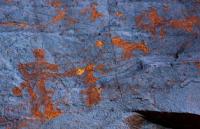You are here
Petroglyphs in Kenkol Valley.

Rock paintings of Kyrgyzstan.
“If you follow the ancient maps written on the stars, no person will ever understand you. So if you could read these maps, would you follow them? And forever be misunderstood? Or would you close your eyes tightly and pretend to be like everyone else?”
C. JoyBell C.
Petroglyphs Talas region in Kyrgyzstan.
Petroglyphs in the Kenkol River Valley The mountain valley of the Kenkol River is located between the main range of Kyrgyz Ala-Too and its spur Kara-Zhylga. All along (about 25km), the valley is quite wide, from 300m in the estuary to 1.5km in its upper reaches.
Elevation difference is insignificant –from 1,300 to 2,000m above sea level (near mountain pass Zhangyz-Archa).
Description of Sites Petroglyphs in the Kenkol river Valley.
The archeological complex in the Kenkol River Valley and its tributaries consists of sites heterogeneous in time and types attributable to nomads. Petroglyphs were registered along the following tributaries: Bakay-Tobo, Terek, Chachykey, Obo, Korgon-Tash, IyriKolot, Terskol, Boorusay, and Chochoy. According to Rysakova R.Ya. (1980–1981), over 546 surfaces with petroglyphs were registered there including in the gorges: Obo -90, Korgon-Tash -26, Chachykey -298, Chochoy -127, Iyri-Kolot -3, Bakay-Toboe -1, and near the Kenkol River bend –1.
Petroglyphs in Kamyrdynbeli and Mount Karaul-Choku can also be put in this group. They are near the estuary of the Kenkol River within the territory of the “Manas-Ordo” Complex, with over 80 engraved surfaces.
Petroglyphs are often concentrated near rivers in the lower parts of gorges, on open surfaces of steep rock shelters and on boulders covered with patina. The method of pecking is mainly with a fine-dot technique, but large-dot and engraving techniques are also found.
The pattern types are: silhouettes, contours, line and sketches. Images and motifs are rather homogeneous. Pictures of wild and domesticated animals, especially mountain goats, isolated or in groups, are predominant; at Obo only there are 362 drawings.
At the same time, each concentration offers more unconventional motifs: at Chochoy –a chariot and a large surface with 59 pictures of various animals and hunting scenes; at Chachykey – hunting scenes, ritual scenes, landscape elements; at Obo – a chariot and others. According to common assumptions, the earliest include a small number of drawings in ditrigonal style (Gaponenko 1963: 101).
The most numerous group includes the ones dated to the Age of early nomads. Some petroglyphs are characteristic of the Early Middle Ages. In this context, a runic inscription with drawings above and below, found in 2005 at Chachykey, is of special interest.
There are palimpsests and refreshed drawings. Tentative dating: from the End of the Bronze Age to the Middle Ages and New Times inclusively.
Protection and Management Petroglyphs in the Kenkol river Valley.
None of the above-listed locations receives government protection, neither do the Kamyrdynbeli petroglyphs on the slopes of low mountains (adyr) near a famous Kenkol burial ground within the territory of the “Manas-Ordo” Museum Complex.
Current Condition of the Sites Petroglyphs in the Kenkol river Valley.
In general, the condition of the sites in the Kenkol River Valley and its tributaries, up to now used for pasture, remains satisfactory. Agricultural land development in the lower part of the valley and gorges adjacent to modern-day settlements runs against a traditional system of natural resources management and increases human influence on the sites.
The project “Scientific Element of Protected Areas in MC “Mans-Ordo” foresees inclusion of territories along adjacent tributaries into the buffer zone of the complex to possibly increase their legal and physical protection.
Authority:
«Rock Art in Kyrgyzstan». Bakyt Amanbaeva, Aiday Suleymanova, Chynarbek Zholdoshev.
Photos by
Alexander Petrov.







